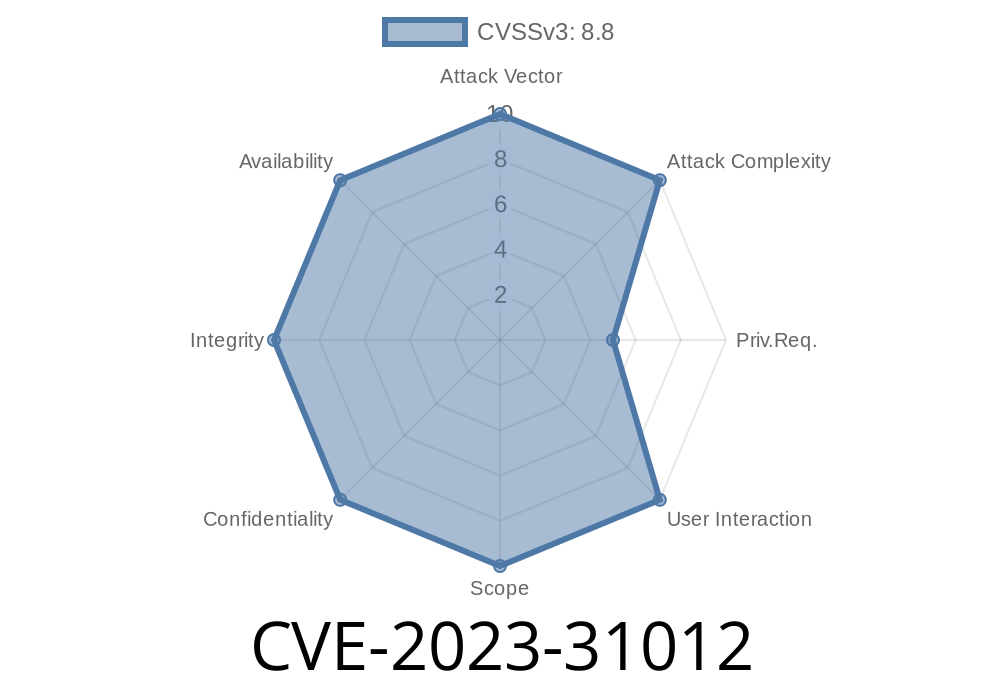---
Introduction
In 2023, NVIDIA disclosed a serious security issue affecting its DGX H100 Baseboard Management Controller (BMC) – identified as CVE-2023-31012. This vulnerability exists in the BMC’s REST service and can let attackers gain unauthorized access, potentially leading to privilege escalation and unearthing sensitive system information. This post delivers an exclusive deep dive into the issue, the underlying code problem, and a real-world exploitation scenario, all in straightforward terms.
What is CVE-2023-31012?
At its core, CVE-2023-31012 is about improper input validation in the REST API of the NVIDIA DGX H100 BMC. When APIs don’t correctly check user-supplied data, attackers can send crafted requests that the server does not expect, triggering security weaknesses.
_Official advisory:_
NVIDIA Product Security Advisory: CVE-2023-31012
Technical Background
The affected system here is the DGX H100 BMC, a remote management chip used to control and monitor NVIDIA’s AI servers. This controller exposes a set of HTTP-based API endpoints (also known as REST APIs) that allow administrators to perform actions such as monitoring temperature, updating firmware, or rebooting the device.
The Vulnerability: Improper Input Validation
The REST API in the BMC should strictly validate every parameter users send, but for some endpoints, it does not. This can make the server perform unauthorized operations or return sensitive information.
Here's a simplified example of what might be happening in the BMC REST API code
# Example vulnerable Python code structure (simplified)
@app.route('/api/getUserInfo', methods=['POST'])
def get_user_info():
# Expects JSON: {"username": "<user>"}
data = request.get_json()
username = data['username']
user_info = database.query("SELECT * FROM users WHERE username='{}'".format(username))
return jsonify(user_info)
Reconnaissance:
The attacker finds out the DGX H100 BMC is running on the target network and that its REST API is exposed.
The attacker sends a POST request with a crafted body to abuse the lack of input validation.
curl -X POST https://target-bmc/api/getUserInfo \
-H 'Content-Type: application/json' \
-d '{"username": "admin"}'
If API lacks authentication or limits, it may return admin credentials.
Privilege Escalation:
By cycling through possible usernames and analyzing responses, the attacker can get details of all users. If changing user roles is also possible via the API, attacker can promote itself.
Information Disclosure:
In some cases, requesting non-existent users or special characters (e.g., *) in the username might return lists of all users or raw database errors, revealing schematics or credentials.
Example Exploit Request
curl -X POST https://target-bmc/api/getUserInfo \
-H "Content-Type: application/json" \
-d '{"username": {"$ne": ""}}'
If backend translates this into a query like WHERE username != '', it could dump all users.
Privilege Escalation: Unauthorized users could gain admin access to the BMC.
- Information Disclosure: Attackers could collect sensitive info like user accounts, network details, and possibly credentials.
- Wider Compromise: With admin on BMC, attackers can reboot main servers, install rogue firmware, or spy on server activities—jeopardizing an entire AI cluster.
NVIDIA issued a patch. Administrators should
1. Update the BMC firmware immediately to the latest version from NVIDIA.
Monitor audit logs for signs of unauthorized BMC API usage.
See NVIDIA’s security bulletin (direct PDF link) for official fixes.
Further Reading
- NVIDIA Security Bulletin: CVE-2023-31012
- Understanding REST API Security
- Firmware Security Recommendations
Summary
CVE-2023-31012 is a critical reminder that improper input validation in server APIs can grant attackers serious power over even cutting-edge AI hardware. While NVIDIA has responded with a patch, this case underscores the importance of secure coding and tight network controls for all management interfaces in modern data centers.
If you run NVIDIA DGX H100 BMC, patch now and restrict that REST API!
Timeline
Published on: 09/20/2023 02:15:00 UTC
Last modified on: 09/22/2023 16:11:00 UTC
